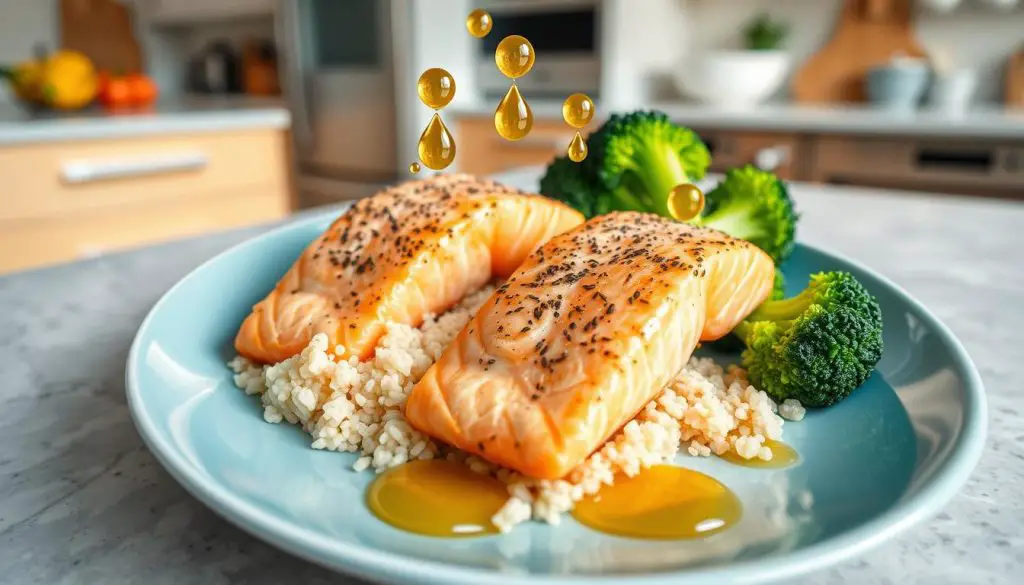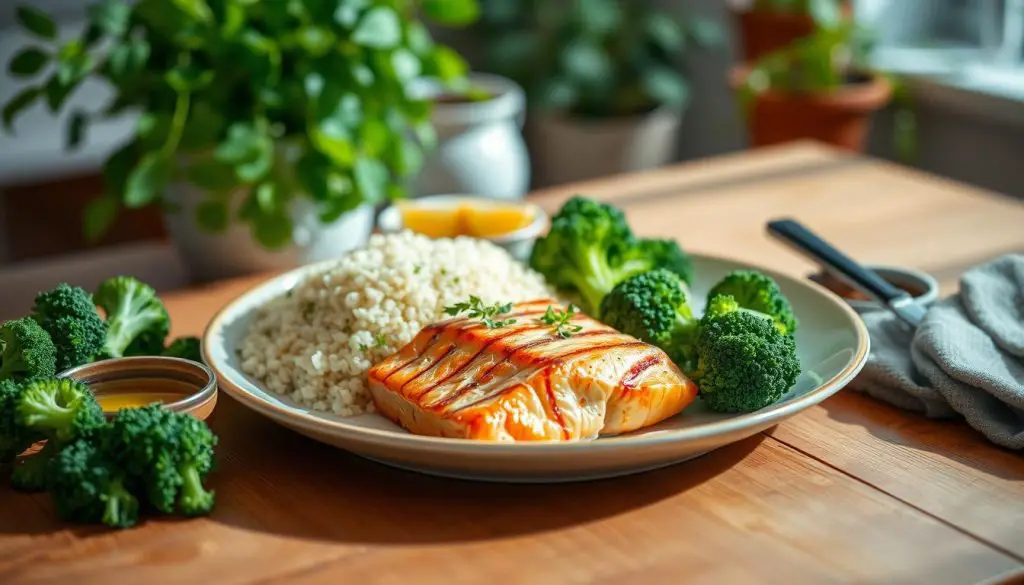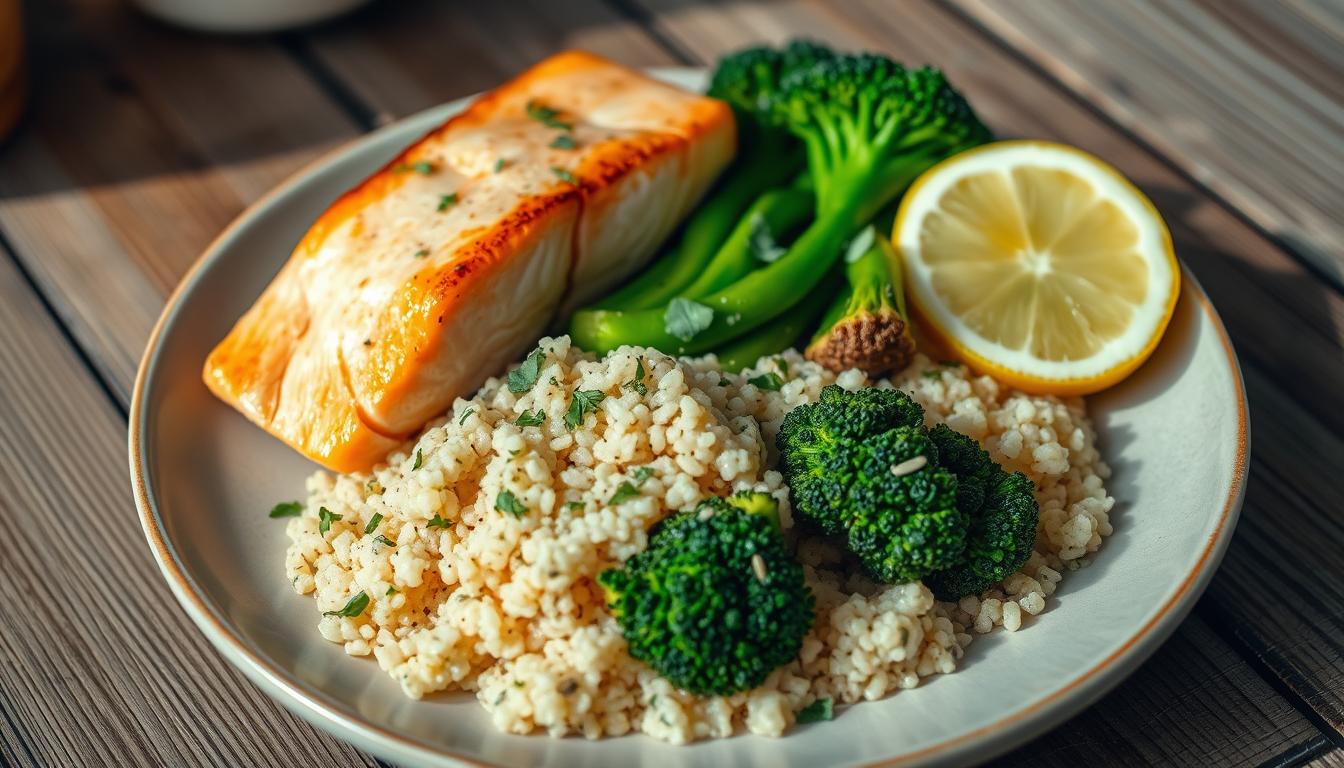Did you know about one in ten women in their reproductive years have endometriosis? That’s a huge number, affecting about 200 million women worldwide. We know how tough this condition can be. That’s why we’re excited to share a tasty and endo-friendly salmon quinoa broccoli meal to help manage symptoms and support health.
This dish is packed with benefits. It has omega-3-rich salmon for its anti-inflammatory effects. It also includes fiber-rich and gluten-free quinoa and antioxidant-packed broccoli. Together, these ingredients make a meal that’s not only delicious but also supports those with endometriosis.
Living with endometriosis can be tough, but we think focusing on anti-inflammatory nutrition and lifestyle can help. Join us as we dive into the endometriosis-friendly diet. Discover how this yummy salmon quinoa broccoli meal can be a key part of managing endometriosis.
What is Endometriosis?
Endometriosis is a chronic, painful condition. It happens when tissue like the uterine lining grows outside the uterus. This tissue grows on other organs in the pelvic area.
This misplaced tissue thickens, breaks down, and bleeds with each menstrual cycle. But, it can’t leave the body. This leads to inflammation, scarring, and adhesions.
Symptoms and Prevalence
The main symptoms include pelvic pain, heavy and painful periods, and painful sex. About 1 in 10 women are affected. Symptoms usually start during the reproductive years (12-60 years old).
Causes and Treatment
The exact cause of endometriosis is not known. But, it might be linked to factors like retrograde menstruation, genetics, and chronic inflammation. There’s no cure, but treatments help manage symptoms.
Pain medication, hormonal therapies, and surgery are common treatments. Laparoscopic surgery is the most effective. It can greatly improve symptoms for many patients.
The Endometriosis Diet: Principles and Benefits
Dealing with endometriosis can be tough, but a special endometriosis diet might help. It’s all about eating foods that fight inflammation and avoiding those that might make symptoms worse.
The diet aims to tackle key issues like estrogen imbalance, inflammation, and gut problems. By choosing foods rich in nutrients and anti-inflammatory properties, people with endometriosis can better manage their symptoms. This might even slow down the disease’s progress.
The endometriosis diet offers many benefits. Studies show it can reduce pain, lower inflammation, and boost overall health. It might also help balance hormones, strengthen the immune system, and improve gut health. All these can help manage endometriosis better.
| Potential Benefits of an Endometriosis Diet |
|---|
| Reduced pain and inflammation |
| Improved hormone balance |
| Enhanced gut health and immune function |
| Increased energy and overall well-being |
By following an anti-inflammatory diet for endometriosis, people can take charge of their health. Making smart food choices and focusing on nourishing the body can help those with endometriosis. It can give them back control and improve their life quality.
Foods to Eat for Endometriosis Relief
If you have endometriosis, eating the right endometriosis-friendly foods can help a lot. Focus on fatty fish rich in omega-3s and cruciferous vegetables packed with antioxidants.
Fatty Fish Rich in Omega-3s
Salmon, mackerel, trout, sardines, and herring are full of omega-3 fatty acids. These omega-3 foods fight inflammation and can make endometriosis pain better. Try to eat these fatty fish a few times a week.
Cruciferous Vegetables and Antioxidants
Broccoli, cauliflower, kale, and more cruciferous vegetables are loaded with antioxidants. They help your body get rid of bad stuff and fight inflammation. Eating a variety of cruciferous veggies every day is good for you.
By eating endometriosis-friendly foods with omega-3s and antioxidants, you can manage your symptoms better. It’s a big step towards feeling better overall.
Foods to Avoid for Endometriosis Management
Managing endometriosis, a chronic condition, requires an anti-inflammatory diet. Some foods help, but others should be avoided. This helps reduce inflammation and pain.
Red Meat and Processed Foods
Red meat and processed foods can worsen endometriosis. They contain inflammatory compounds like arachidonic acid. This can increase prostaglandins and pain.
Research shows a 56% higher risk of endometriosis with more red meat.
Gluten and Inflammatory Foods
Gluten in wheat, rye, and barley can increase inflammation in endometriosis. A 2012 study found 75% of women felt better without gluten.
It’s also wise to cut down on other inflammatory foods. These include processed snacks, fried foods, and refined carbs. They can make symptoms worse.
Avoiding these foods and eating an anti-inflammatory diet can help manage endometriosis. It improves overall health and well-being.

Endo friendly salmon quinoa broccoli
For those with endometriosis, finding meals that are both nourishing and endo-friendly is key. Our endo-friendly salmon, quinoa, and broccoli recipe is a great choice.
Nutritional Benefits
This dish is packed with anti-inflammatory nutrients. The salmon has omega-3 fatty acids that fight inflammation. The quinoa offers fiber, complex carbs, and vitamins and minerals. The broccoli is full of antioxidants and compounds that help with endometriosis symptoms.
Recipe and Instructions
To make this meal, you’ll need:
- 4 oz wild-caught salmon fillets
- 1 cup cooked quinoa
- 2 cups steamed broccoli florets
- 1 tbsp extra-virgin olive oil
- 1 tsp lemon juice
- Salt and pepper to taste
Instructions:
- Preheat your oven to 400°F (200°C).
- Brush the salmon fillets with 1 tsp of olive oil and season with salt and pepper.
- Place the salmon on a baking sheet and roast for 12-15 minutes, or until it flakes easily with a fork.
- In a large bowl, combine the cooked quinoa, steamed broccoli, remaining 2 tsp of olive oil, and lemon juice. Season with salt and pepper.
- Serve the salmon alongside the quinoa and broccoli mixture for a nourishing and endo-friendly meal.
This dish is not only delicious but also packed with nutrients. It’s a great addition to your endo-friendly meals.
Incorporating Omega-3 Fatty Acids
Adding omega-3 fatty acids to your diet can change the game for managing endometriosis. These anti-inflammatory fats are key in reducing inflammation. This inflammation fuels endometriosis.
Fatty fish like salmon and trout are great sources of omega-3s. Try to eat them a few times a week. For plant-based options, flaxseeds and walnuts are also good.
Adding other anti-inflammatory foods like dark leafy greens, berries, and turmeric can boost benefits. A diet full of these can help manage symptoms and improve health.

Adding omega-3s to your life is a simple yet powerful step against endometriosis. Look into omega-3-rich foods and try endo-friendly recipes. This way, you can nourish your body and find relief.
The Role of Anti-Inflammatory Herbs and Spices
Incorporating anti-inflammatory herbs and spices into your diet can help manage endometriosis symptoms. These ingredients not only add flavor to your meals but also offer anti-inflammatory benefits. They can help reduce pain and discomfort caused by this condition.
Turmeric is a well-studied herb with strong anti-inflammatory properties. Its active compound, curcumin, can help reduce endometriosis lesions and lower body inflammation. Ginger is also effective, reducing inflammation and easing menstrual cramps.
Cinnamon is another spice that can benefit those with endometriosis. It has been shown to lower inflammation and ease chronic pelvic pain. Garlic and rosemary are also anti-inflammatory and can be added to many dishes.
Using anti-inflammatory herbs and anti-inflammatory spices can help manage endometriosis. This approach can reduce the need for medications. Try different combinations to find what works best for you.
Managing Endometriosis with Diet and Lifestyle
Endometriosis is a complex condition that needs a multi-faceted approach. Diet can help with inflammation and pain, but lifestyle matters too. Eating anti-inflammatory foods and managing stress, getting enough sleep, and staying active are key. This holistic approach helps manage endometriosis management.
The Endometriosis Diet: Principles and Benefits
The diet for endometriosis focuses on anti-inflammatory foods. Healthy fats in oily fish, avocados, and nuts are great. Also, eat lots of broccoli, kale, and Brussels sprouts for antioxidants.
Lifestyle Modifications for Endometriosis Relief
- Regular physical activity, like stretching, yoga, swimming, or walking, helps symptoms.
- Stress management, through meditation, deep breathing, or therapy, is important.
- Getting enough sleep is key, as lack of sleep worsens inflammation.
Combining diet and lifestyle changes helps manage endometriosis. It’s a journey, and seeking help from healthcare professionals is important. They can offer personalized advice.

| Nutrient | Benefits for Endometriosis |
|---|---|
| Omega-3 Fatty Acids | Reduce inflammation and manage pain |
| Antioxidants | Counter inflammatory effects of endometriosis |
| Fiber | Promote gut health and reduce inflammation |
| Vitamin E | Alleviate pelvic pain associated with endometriosis |
Meal Planning and Food Journaling
Starting an endometriosis-friendly diet needs a smart plan for meals and keeping a food journal. By planning meals ahead, we make sure we eat foods that are good for us and help with symptoms. Meal planning also helps us avoid wasting food and enjoy our meals more.
Keeping a food journal is just as key. It lets us see which foods might cause problems and make better choices. By tracking what we eat, we can find patterns and adjust our diet to fit our needs.
For meal planning for endometriosis, try new recipes and ingredients. Add foods like fatty fish, leafy greens, and spices to your meals. Try different ways of cooking and flavors to keep things interesting and healthy.
Food journaling for endometriosis is also very helpful. By tracking symptoms and how our body reacts to food, we can spot patterns. This self-discovery can lead to big improvements in how we feel.
Remember, finding the right diet for endometriosis is a personal journey. What works for one person might not work for another. By using meal planning and food journaling, we can take charge of our health. We can find relief from symptoms and appreciate the foods that help us feel good.
Seeking Professional Guidance
Managing endometriosis well means getting help from experts. Working with an endometriosis specialist, gynecologist, or nutritionist is key. They help create a treatment plan just for you. These professionals offer insights and support for dealing with endometriosis’s complex symptoms and causes.
Endometriosis can be tough to handle, and getting professional help is vital. It helps manage symptoms and improves life quality. With healthcare providers, we can tackle both medical and nutritional sides of endometriosis, leading to better results.
We’re not alone in this fight. An endometriosis specialist or nutritionist can offer the support and care we need. They help us manage endometriosis well and take charge of our health.

Supporting Gut Health for Endometriosis Relief
Research shows a strong connection between gut health and endometriosis. Intestinal permeability, or “leaky gut,” is a key factor. It lets undigested food, toxins, and bacteria into the bloodstream. This can cause inflammation and immune problems, both linked to endometriosis.
To help gut health and ease endometriosis symptoms, we can try several things:
- Probiotic-rich foods: Yogurt, kefir, kimchi, and sauerkraut boost good gut bacteria.
- Fiber-rich foods: Broccoli, lentils, and flaxseeds help control blood sugar and insulin.
- Anti-inflammatory herbs and spices: Ginger, turmeric, and extra virgin olive oil fight inflammation.
Adding probiotics to our diet can also help. Studies show they can balance the immune system, reduce inflammation, and ease pain.
Improving gut health is vital for managing endometriosis. By using these strategies, we can improve our overall health and lessen the symptoms of this chronic condition.
Stress Management and Endometriosis
Dealing with endometriosis can feel like a big challenge. But, using stress management techniques every day can really help. Chronic stress can make endometriosis symptoms worse and even slow down treatment. By focusing on stress management, we can improve our health and find comfort.
Mind-Body Techniques
Adding mind-body techniques to your treatment plan can be very effective. Activities like meditation, yoga, and deep breathing can lower stress and boost well-being. They help us find peace and balance, easing the physical and emotional pain of endometriosis.
- Meditation can calm the mind, reduce anxiety, and help handle pain better.
- Yoga mixes physical poses, breathing, and mindfulness, helping with stress and pain.
- Deep breathing exercises calm the nervous system, leading to relaxation and less inflammation.
By making these mind-body techniques a part of your daily life, you can take charge of your endometriosis symptoms. It’s important to find what works best for you, as everyone reacts differently to these practices.
Endometriosis and Fertility Considerations
Managing endometriosis means looking at its impact on fertility too. This condition can harm fertility due to scarring, inflammation, and hormonal issues. In fact, endometriosis is linked to 35-50% of fertility problems in women. Also, 24 to 50% of women with infertility have endometriosis.
For those with endometriosis planning to get pregnant, early action is key. Working with healthcare providers to create a fertility plan is essential. This plan might include diet changes, lifestyle adjustments, and medical treatments. It’s wise to talk to a registered dietitian or fertility expert before making big changes.
Even with challenges, we can manage endometriosis and support our fertility dreams. Understanding endometriosis and its fertility link helps us make informed choices. We can take steps towards starting a family.
Source Links
- https://www.businessinsider.com/guides/health/conditions-symptoms/endometriosis-diet
- https://sofreshnsogreen.com/recipes/endometriosis-diet-recipes/
- https://drkathleenmahannah.com/blog/endometriosis-foods-to-eat-and-avoid
- https://www.ssmhealth.com/SSMHealth/media/Documents/slucare/services/obstetrics-gynecology-womens-health/endometriosis-diet-booklet.pdf
- https://www.verywellhealth.com/endometriosis-diet-7105372
- http://drlisawatson.com/endometriosis-diet
- https://www.health.com/condition/endometriosis/endometriosis-diet
- https://www.naturalfertilityandwellness.com/endometriosis-diet-menu-plan/
- https://floliving.com/blog-categories/endometriosis
- https://www.endo-resolved.com/endometriosis_diet_protein.html
- https://www.healendo.com/food-inspo
- https://www.primeivfcentre.com/blog/foods-to-improve-female-egg-quality
- https://bigsisnutrition.com.au/resources/nutrition-for-adenomyosis/
- https://www.theendobellycoach.com/podcast/foods-for-endo-pain
- https://www.anhwellness.org/post/anti-inflammatory-diets-what-to-know
- https://chiavaye.com/blogs/endometriosis/endometriosis-diet-tips?srsltid=AfmBOorqckcCJTD-gF-es9JFtou-LnXBQPIR6WsWvX5Li8tWVDkir-nb
- https://www.verywellfit.com/hormone-balancing-meal-plan-8304151
- https://www.usenourish.com/blog/7-day-meal-plan-for-pancreatitis
- https://www.acibademhealthpoint.com/healthy-endometriosis-recipes-for-relief-comfort/
- https://endometriosisnews.com/2020/04/16/anti-inflammatory-diet-covid-19-finding-healthy-foods/
- https://chiavaye.com/blogs/endometriosis/endometriosis-diet-tips?srsltid=AfmBOoo02SnjKVNbGo5Ku0rbEs4kfRiFqtH6WyKzVA0zTlP5hWQDQDup
- https://valehealth.co.uk/blog
- https://chiavaye.com/blogs/endometriosis/endometriosis-diet-tips?srsltid=AfmBOoqVJ5ZY9LKVhkBpq-3nF5KVE9Dc7tcZw8e1n_FFgqoyMStOr1xe
- https://natural-fertility-info.com/endometriosis
- https://birlafertility.com/blogs/what-to-eat-and-what-to-avoid-in-endometriosis/
